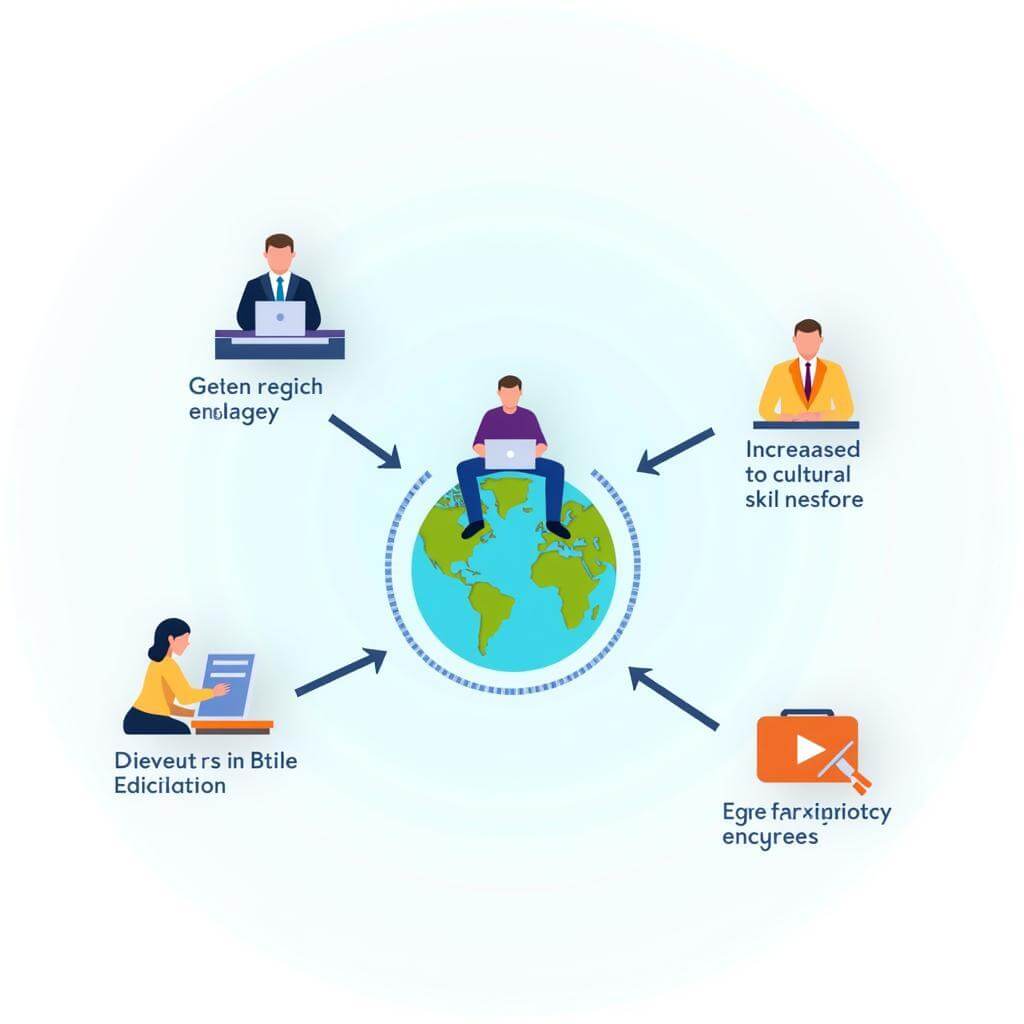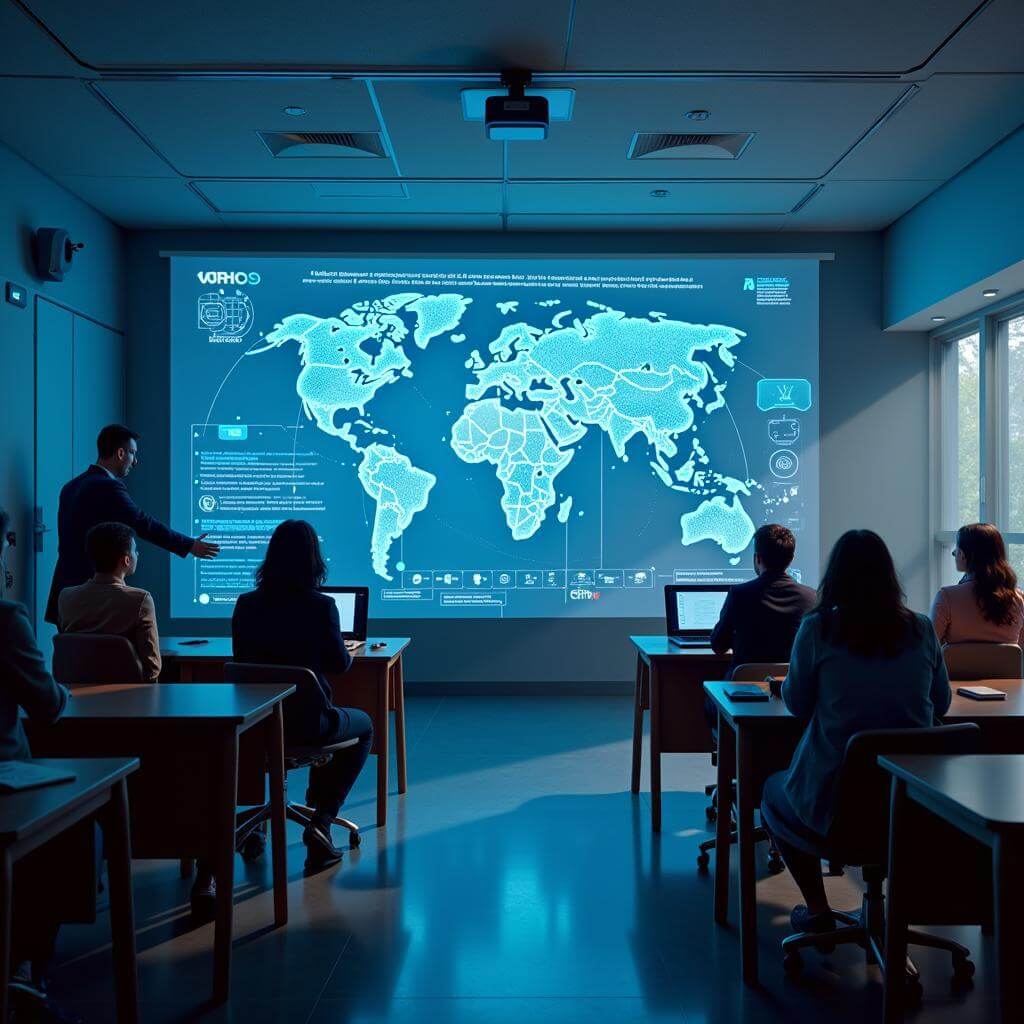In today’s interconnected world, virtual mentoring has emerged as a powerful tool in global education. This IELTS Reading practice test explores this transformative trend and its impact on learning across borders. Let’s dive into the passages and test your comprehension skills.
Passage 1 – Easy Text
The Growth of Virtual Mentoring
Virtual mentoring, a relatively new concept in education, has gained significant traction in recent years. This innovative approach connects students with mentors from around the world, breaking down geographical barriers and fostering cross-cultural understanding. Unlike traditional face-to-face mentoring, virtual mentoring leverages technology to facilitate communication and knowledge sharing.
The rise of virtual mentoring can be attributed to several factors. Firstly, the proliferation of high-speed internet and advanced communication tools has made it easier than ever to connect globally. Secondly, the increasing demand for international exposure in education has created a need for more diverse mentoring experiences. Lastly, the flexibility offered by virtual mentoring allows for more convenient scheduling and reduced costs compared to traditional mentoring programs.
One of the key benefits of virtual mentoring is its ability to provide students with access to expertise that may not be available locally. For instance, a student in a small town can now receive guidance from a leading expert in their field of interest, regardless of geographical constraints. This democratization of knowledge has the potential to level the playing field in education and career development.
The rise of cultural immersion experiences in education has also contributed to the growing popularity of virtual mentoring. As students seek to broaden their horizons and gain global perspectives, virtual mentoring offers a complementary approach to cultural exchange without the need for physical travel.
However, virtual mentoring is not without its challenges. Building trust and rapport in a virtual environment can be more difficult than in person. Additionally, technical issues and time zone differences can sometimes hinder effective communication. Despite these obstacles, many educational institutions and organizations are investing in virtual mentoring programs, recognizing their potential to enhance learning outcomes and prepare students for an increasingly globalized workforce.
 Virtual mentoring connecting students globally
Virtual mentoring connecting students globally
Questions 1-5
Do the following statements agree with the information given in the passage? Write
TRUE if the statement agrees with the information
FALSE if the statement contradicts the information
NOT GIVEN if there is no information on this
- Virtual mentoring is a concept that has been widely used in education for decades.
- High-speed internet has contributed to the growth of virtual mentoring.
- Virtual mentoring is always more cost-effective than traditional mentoring.
- Students in remote areas can benefit from expert guidance through virtual mentoring.
- All educational institutions have fully replaced traditional mentoring with virtual programs.
Questions 6-10
Complete the sentences below. Choose NO MORE THAN TWO WORDS from the passage for each answer.
- Virtual mentoring helps promote __ __ between people from different cultures.
- One advantage of virtual mentoring is its __ in terms of scheduling.
- The __ of knowledge through virtual mentoring can help equalize educational opportunities.
- Building __ in a virtual environment can be more challenging than in face-to-face interactions.
- Many organizations see virtual mentoring as a way to prepare students for a more __ workforce.
Passage 2 – Medium Text
The Impact of Virtual Mentoring on Global Education
The advent of virtual mentoring has ushered in a new era of global education, revolutionizing the way knowledge is shared and acquired across borders. This innovative approach to learning and guidance has profound implications for students, educators, and institutions worldwide, reshaping the landscape of educational opportunities and professional development.
One of the most significant impacts of virtual mentoring is its ability to transcend geographical limitations. In the past, students were often constrained by their physical location when seeking mentorship or specialized knowledge. Now, a student in rural Africa can receive guidance from a Nobel laureate in Europe, or an aspiring entrepreneur in Asia can learn from a successful business leader in North America. This global reach not only expands the pool of available mentors but also exposes students to diverse perspectives and expertise that were previously inaccessible.
How educational technology is changing student engagement is closely tied to the rise of virtual mentoring. The platforms and tools used for virtual mentoring often incorporate features that enhance engagement, such as real-time collaboration, multimedia sharing, and progress tracking. These technological advancements have made mentoring sessions more interactive and tailored to individual learning styles.
Furthermore, virtual mentoring has proven to be a catalyst for cultural exchange and global citizenship. By connecting individuals from different parts of the world, it fosters cross-cultural understanding and breaks down stereotypes. Students learn not only about their specific areas of interest but also gain insights into different cultures, work ethics, and global issues. This exposure is invaluable in preparing them for careers in an increasingly interconnected world.
The flexibility offered by virtual mentoring has also made it an attractive option for working professionals seeking to upgrade their skills or transition to new careers. Unlike traditional mentoring programs that might require physical presence, virtual mentoring allows participants to engage in learning opportunities without disrupting their current work or family commitments. This accessibility has democratized mentorship, making it available to a broader range of individuals regardless of their circumstances.
However, the rise of virtual mentoring is not without challenges. Issues such as digital divide and unequal access to technology can create disparities in who can benefit from these programs. Additionally, the lack of face-to-face interaction can sometimes lead to miscommunication or a sense of disconnection between mentor and mentee. Educational institutions and policymakers are grappling with these challenges, seeking ways to ensure that the benefits of virtual mentoring are equitably distributed and that the quality of mentorship remains high.
 Virtual mentoring's impact on global education
Virtual mentoring's impact on global education
Despite these challenges, the potential of virtual mentoring to transform global education remains immense. As technology continues to evolve and best practices are refined, virtual mentoring is likely to become an increasingly integral part of educational ecosystems worldwide. Its ability to connect minds across vast distances, foster innovation, and prepare learners for the complexities of a global society positions virtual mentoring as a key driver in the future of education.
Questions 11-14
Choose the correct letter, A, B, C, or D.
-
According to the passage, one of the main advantages of virtual mentoring is:
A) It is always cheaper than traditional mentoring
B) It allows students to meet their mentors in person
C) It provides access to mentors from around the world
D) It guarantees job placements for students -
The passage suggests that virtual mentoring platforms often include features that:
A) Replace the need for human mentors
B) Increase student engagement
C) Teach students how to code
D) Are too complex for most users -
The author mentions the “digital divide” as:
A) A benefit of virtual mentoring
B) A challenge faced by virtual mentoring programs
C) A new type of mentoring software
D) A solution to geographical limitations -
Based on the passage, which of the following is NOT mentioned as a benefit of virtual mentoring?
A) Promoting cultural exchange
B) Providing flexibility for working professionals
C) Offering specialized knowledge from experts
D) Eliminating the need for formal education
Questions 15-20
Complete the summary below. Choose NO MORE THAN TWO WORDS from the passage for each answer.
Virtual mentoring has had a (15) __ impact on global education by allowing knowledge to be shared across borders. It enables students to access mentors and expertise that may not be available in their (16) __, thus expanding their learning opportunities. This form of mentoring also promotes (17) __ __, preparing students for an interconnected world. The (18) __ of virtual mentoring makes it particularly suitable for working professionals looking to enhance their skills. However, challenges such as the (19) __ __ need to be addressed to ensure equal access. Despite these issues, virtual mentoring is expected to play an (20) __ role in shaping the future of education globally.
Passage 3 – Hard Text
The Paradigm Shift: Virtual Mentoring and the Future of Global Education
The emergence of virtual mentoring as a cornerstone of global education represents a paradigm shift in the way knowledge is disseminated and acquired across international boundaries. This transformative approach to learning and professional development has catalyzed a reimagining of educational methodologies, challenging traditional notions of mentorship and fostering a more interconnected, globally-minded academic community.
At the heart of this revolution lies the symbiosis between cutting-edge technology and pedagogical innovation. Virtual mentoring platforms have evolved beyond mere communication tools, incorporating sophisticated algorithms that facilitate optimal mentor-mentee matching based on a multitude of factors including academic interests, career aspirations, and even personality traits. This nuanced approach to pairing has led to more fruitful mentoring relationships, transcending the limitations often encountered in traditional, locality-based mentoring programs.
The democratization of expertise brought about by virtual mentoring has had far-reaching implications for educational equity. Students from underserved communities or resource-constrained institutions now have unprecedented access to luminaries in their fields of interest, effectively leveling the playing field in terms of guidance and networking opportunities. This democratization extends beyond academia, permeating into professional spheres and contributing to a more meritocratic global workforce.
How AI is transforming education is intrinsically linked to the evolution of virtual mentoring. Artificial Intelligence is being harnessed to enhance the mentoring experience, from predicting potential areas of synergy between mentors and mentees to providing real-time language translation services that facilitate cross-cultural mentoring relationships. These AI-driven enhancements are not only making mentoring more accessible but also more effective, tailoring the experience to individual learning styles and goals.
However, the proliferation of virtual mentoring has also brought to the fore several ethical and practical considerations. The digital divide remains a significant barrier, with disparities in internet access and technological literacy potentially exacerbating existing educational inequalities. Moreover, the preservation of data privacy and the establishment of clear boundaries in virtual mentoring relationships pose ongoing challenges that require careful navigation.
The role of digital transformation in education is exemplified by the integration of virtual mentoring into formal curricula. Educational institutions are increasingly recognizing the value of virtual mentoring as a complement to traditional teaching methods, incorporating it into degree programs and professional development courses. This integration is blurring the lines between formal and informal learning, creating more holistic educational experiences that better prepare students for the complexities of the modern workforce.
The scalability of virtual mentoring presents both opportunities and challenges. On one hand, it allows for the rapid expansion of mentoring programs, potentially reaching millions of learners worldwide. On the other, maintaining the quality and personalization of mentoring at scale requires innovative approaches to program design and management. Some institutions are exploring hybrid models that combine elements of virtual and in-person mentoring, seeking to leverage the benefits of both approaches.
As virtual mentoring continues to evolve, its impact on global education is likely to be profound and multifaceted. It has the potential to foster greater international collaboration in research and innovation, as mentoring relationships spark cross-border partnerships and knowledge exchange. Furthermore, the exposure to diverse perspectives inherent in global virtual mentoring programs may contribute to the development of more culturally competent and globally minded professionals.
 The future of global education through virtual mentoring
The future of global education through virtual mentoring
The future trajectory of virtual mentoring in global education will likely be shaped by ongoing technological advancements, particularly in the realms of virtual and augmented reality. These technologies have the potential to create more immersive mentoring experiences, further bridging the gap between virtual and in-person interactions. As these tools become more sophisticated and widely available, they may revolutionize the way knowledge is shared and relationships are built across vast distances.
In conclusion, virtual mentoring stands at the vanguard of a new era in global education, promising to reshape the landscape of learning and professional development. Its ability to transcend geographical, cultural, and socioeconomic boundaries positions it as a powerful force for educational equity and global understanding. As educators, policymakers, and technologists continue to refine and expand virtual mentoring initiatives, they must remain mindful of both its transformative potential and the challenges it presents, working collaboratively to ensure that this innovative approach to mentorship fulfills its promise of democratizing knowledge and fostering a more interconnected global community of learners and leaders.
Questions 21-26
Complete the sentences below. Choose NO MORE THAN TWO WORDS from the passage for each answer.
-
Virtual mentoring represents a __ __ in how knowledge is shared globally.
-
Sophisticated algorithms are used to match mentors and mentees based on factors including __ __.
-
The __ brought about by virtual mentoring has improved educational equity.
-
AI is being used to provide __ __ services to facilitate cross-cultural mentoring.
-
The __ of virtual mentoring programs allows them to potentially reach millions of learners.
-
Future developments in __ __ technology may create more immersive mentoring experiences.
Questions 27-33
Do the following statements agree with the information given in the passage? Write
YES if the statement agrees with the views of the writer
NO if the statement contradicts the views of the writer
NOT GIVEN if it is impossible to say what the writer thinks about this
-
Virtual mentoring has completely replaced traditional mentoring in most educational institutions.
-
The digital divide may worsen existing educational inequalities through virtual mentoring.
-
All virtual mentoring programs use AI for matching mentors and mentees.
-
Virtual mentoring is being integrated into formal educational curricula by some institutions.
-
Hybrid models combining virtual and in-person mentoring are being explored by some organizations.
-
Virtual mentoring has had no impact on international research collaboration.
-
Virtual and augmented reality will definitely be used in all future virtual mentoring programs.
Questions 34-40
Complete the summary below. Choose NO MORE THAN TWO WORDS from the passage for each answer.
Virtual mentoring is transforming global education by leveraging technology to connect mentors and mentees across borders. This approach has led to the (34) __ of expertise, giving students from (35) __ __ access to leading experts in their fields. The integration of (36) __ __ has enhanced the mentoring experience, making it more tailored and effective.
However, challenges such as the (37) __ __ and data privacy concerns need to be addressed. The (38) __ of virtual mentoring programs offers great potential but also raises questions about maintaining quality at scale. Some institutions are exploring (39) __ __ that combine virtual and face-to-face mentoring.
Looking to the future, advancements in virtual and augmented reality may create more (40) __ mentoring experiences, further revolutionizing global education and professional development.
Answer Key
Passage 1
- FALSE
- TRUE
- NOT GIVEN
- TRUE
- FALSE
- cross-cultural understanding
- flexibility
- democratization
- trust
- globalized
Passage 2
- C
- B
- B
- D
- profound
- location
- cultural exchange
- flexibility
- digital divide
- integral
Passage 3
- paradigm shift
- career aspirations
- democratization of expertise
- real-time language
- scalability
- virtual reality
- NO
- YES
- NOT GIVEN
- YES
- YES
- NO
- NOT GIVEN
- democratization
- underserved communities
- artificial intelligence
- digital divide
- scalability
- hybrid models
- immersive
The rise of online learning in higher education has significantly contributed to the growth and acceptance of virtual mentoring as an integral part of modern educational practices. As students and educators become more comfortable with online learning environments, the transition to virtual mentoring becomes more natural and effective.


